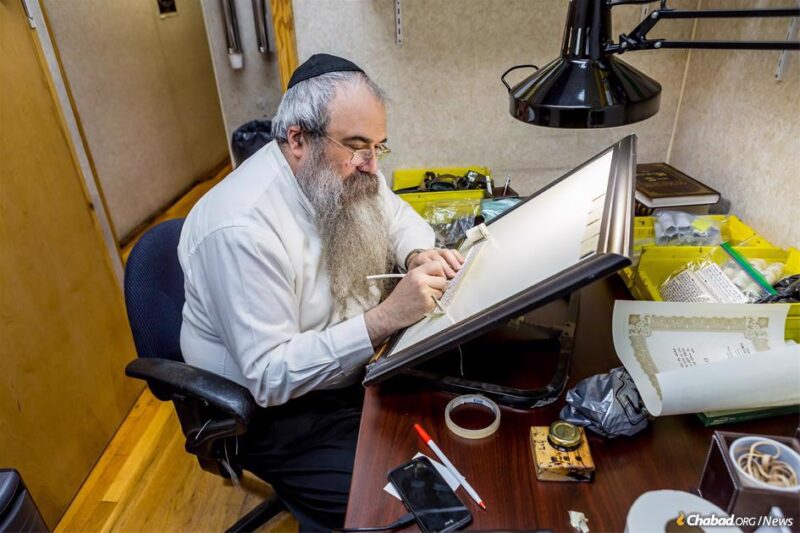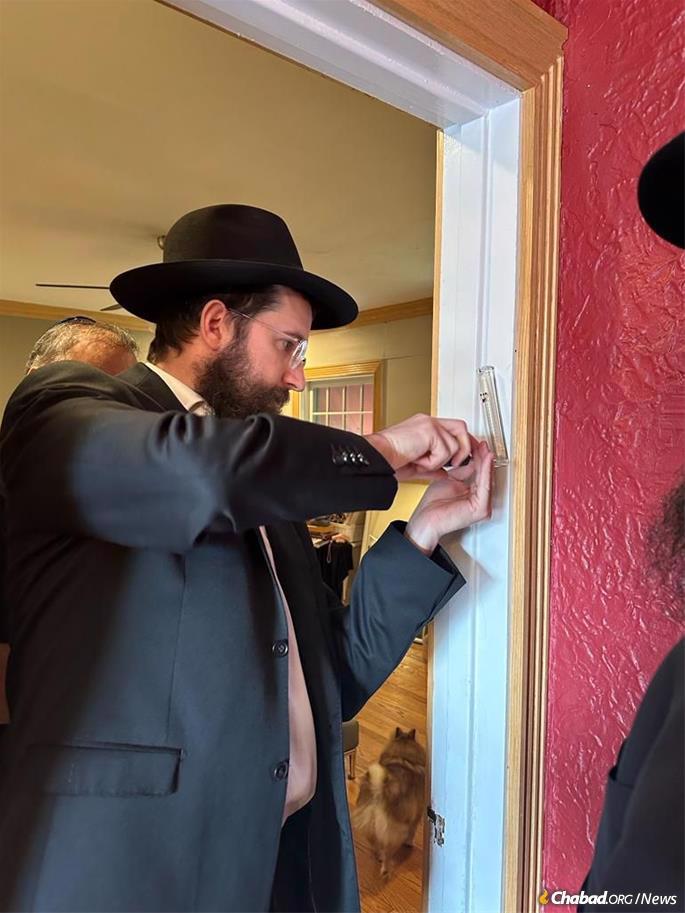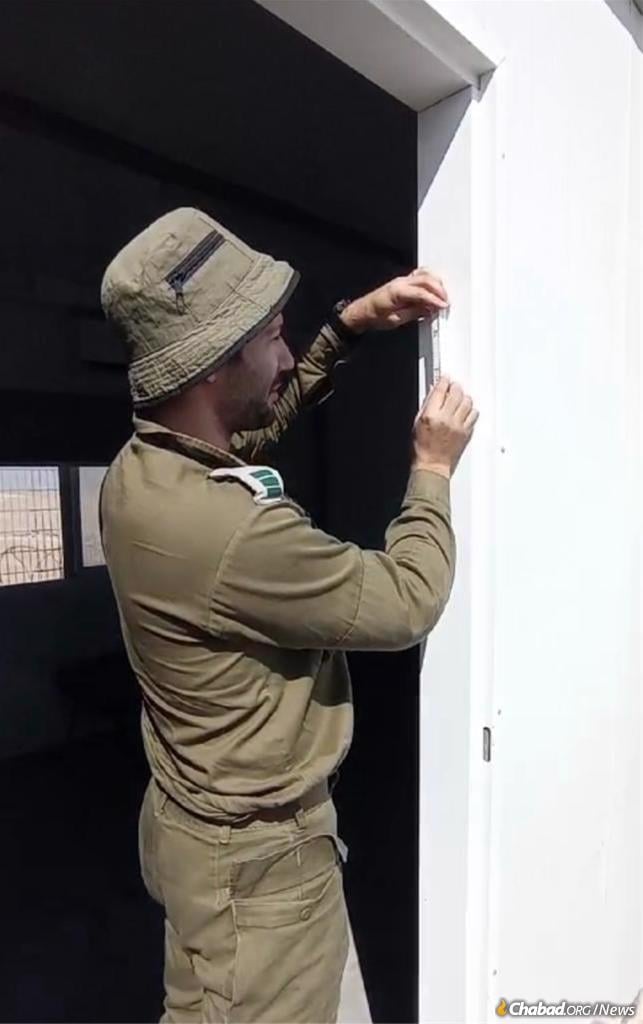
War in Israel Drives International Demand for Mezuzahs and Tefillin
by Faygie Levy Holt – chabad.org
Over the decades, from his perch at Atara’s Judaica on Fairfax Avenue in Los Angeles, Rabbi Yosef Mishulovin has sold countless mezuzahs and pairs of tefillin. But the pace of those sales over the last four weeks has been unprecedented.
“I am sold out of tefillin. I’ve sold a lot of mezuzahs in recent days. I’m trying to get enough supply for all the requests,” says Mishulovin, a Chabad-Lubavitch emissary who has run Chabad on Fairfax/Atara’s Judaica store in L.A. since 1975. “I’ve never seen this much interest.”
He pauses to consider the cause for the newfound demand for the holy objects. “People are awakening; they are awakening,” he explains. “Plain and simple: They want to do a lot more mitzvot for the sake of their brethren in Israel.”
In the month since Hamas’s brutal terror attacks in southern Israel on Oct. 7, rabbis, Jewish community leaders and laypeople across the globe have seen a groundswell of interest among Jews of all backgrounds for all things Jewish. This has manifested itself, in particular, in demand for mezuzahs to guard their homes, offices and college dorm rooms, as well as tefillin with which they can pray daily.
Like Torah scrolls, mezuzahs and tefillin are painstakingly handwritten by expert Jewish scribes, called sofers. Mezuzahs are rolled up scrolls of parchment with the words of the Shema—which is Judaism’s central prayer and proclaims G‑d’s singular unity—written inside. The scrolls are placed inside a case, which can be plain or elaborately decorative, and per the Torah’s command hung on the doorways of Jewish homes and businesses. Aside from proudly announcing the home to be a Jewish one, the “very purpose of the mezuzah is the protection of the house and its inhabitants.”
In 1974 the Rebbe—Rabbi Menachem M. Schneerson, of righteous memory—launched his international Mezuzah Campaign, encouraging Jews who did not have them to affix kosher mezuzahs on their homes and places of business, and those who did to check them regularly to make sure they were indeed kosher.
Tefillin are black leather boxes that likewise contain the Shema prayer, as well as three other passages from the Torah, and are worn every day by Jewish men over the age of 13. The Rebbe began his Tefillin Campaign in the runup to the 1967 Six-Day War, calling upon all Jewish soldiers, soon expanding it to all men, to don tefillin. At the time, Israel and its millions of inhabitants were being threatened with decimation by their surrounding enemies, and the Rebbe cited the verse in Deuteronomy that “the nations of the land will see that the name of G‑d is called upon you” and run away fearfully—which the sages explain refers to tefillin—as one explanation as to why this mitzvah, in particular.
In the years since, countless Jews around the world have hung mezuzahs at their doorposts or donned tefillin, these rightly being seen as especially important during times of grave danger for the Jewish people.

Demand and Supply
Among the many Jews who’ve hung a mezuzah on their doorpost since the Oct. 7th terror attack are Henry Brooks and Sophie Ross of Manhattan’s Lower East Side, who received the brand-new scroll from Tech Tribe, a Brooklyn-based division of Chabad Young Professionals that works with Jews in tech and digital media. Ten days into the war, Tech Tribe’s director Rabbi Mordechai Lightstone showed up at their apartment to help affix the holy scroll.
“The hatred and devastation our community is experiencing has made us embrace our Jewish identities more than ever,” Ross explains. “Not only did we finally put up a mezuzah following the Oct. 7 massacre, but I’m also wearing a Magen David for the first time, and ordered several books about Judaism and antisemitism, trying to learn everything I can about my heritage, and those who’ve tried to snuff it out over and over again throughout history.”
In the aftermath of the terror attack Ross had read online about Jews in other parts of the globe being scared to leave their mezuzahs on their doors. “I think it’s a wonderful privilege to be able to proudly put up a mezuzah at this moment,” she says.

There might not yet be a shortage in New York, but that’s not the case in many other parts of the world. Mezuzahs and tefillin cannot be mass-produced, requiring focused attention from the scribes who create them. Even the slightest wobble of a quill can render the item unsuitable for use. Therefore, fulfilling the sudden increased demand is challenging.
Rabbi Avromy Super, the Chabad emissary on the Caribbean island of S. Lucia, launched a campaign in the wake of the terror attacks promising to give a free pair of tefillin to anyone who agreed to put them on each day. Since the campaign launched and its subsequent amplification by the owners of the Dan’s Deals website, some 3,000 pairs have been requested. It will take months to meet all the demand, says Super.
“We’ve bought all we could get our hands on, and now we are having hundreds of more pairs written, but the sofers just can’t write them fast enough. We have been sourcing from all around the world,” Super says. “One scribe in Australia that I contacted told me he only had a handful of pairs of tefillin left as the local demand has surged in the last few weeks as well.”
Like many others, when Tzvi Rappaport of Brooklyn, N.Y., heard about the war in Israel, he wanted to do something. Rappaport decided to purchase and donate mezuzahs for Israeli soldiers whose homes may not have one to help and keep them safe. He reached out to family, friends and colleagues for donations, and within 24 hours, he had raised enough to purchase 100 mezuzahs.
Then the requests started coming in. They came from people he knows in Israel, from group lists, from army bases. Everyone, it seems, knew someone who wanted a mezuzah. Rappaport went about securing more, but he faced the problem that many others had—more demand than supply.
“Because we are doing this as a shmira, a ‘protection,’ we didn’t want to use the cheapest mezuzah on the market,” he said. “We limited ourselves to a specific type. One company told me it would take between two and four weeks to get them. I went with another company. Sometimes, it will take a day or two before we can get them, but we are managing.”
At this point, Rappaport has sourced nearly 600 mezuzahs and has requests for another 160. This time it isn’t just from soldiers, but also from people who have been evacuated from the north and south of Israel as the war has heated up.

Demand, Bottleneck, but Spiritual Items on Their Way
Rappaport is just one of the many individuals who has conducted a mezuzah campaign. Similar awareness and promotion campaigns are taking place throughout Israel, and in the United States as well, where college students at several colleges have been requesting mezuzahs to put up on the dorm rooms.
At Otzar HaStam Tzfat center in Israel’s northern city of Safed, a group of 30 expertly-trained scribes work year-round to produce high quality tefillin and mezuzahs. Even before the war began, explains Rabbi Chaim Kaplan, a Chabad emissary to the city and the executive director of Otzar HaStam, there was a supply deficit, with one major client waiting on some 2,000 mezuzahs.
“When you make a mezuzah, you can’t just push a button and create more,” he says. “It is all handmade, and whenever there is a big demand, there’s a bottleneck.”
It can take between three and 10 days to write a pair of tefillin and a day or two to write a mezuzah, depending on the quality of the work. Once an item is completed it goes through a two-stage checking process—first it is checked by a computer and then by another scribe to ensure there are no errors. Only then can it be rendered kosher for use.
At that point, the mezuzah can be rolled and placed in a case for usage. Tefillin need even more time, requiring the leather box be stitched up and assembled—all by hand—before it can be used.
Safed is not feeling the effects of the war in the same way frontline towns and cities are, though Kaplan says it is still impacting the center’s output. Both Otzar HaStam’s manager and director have been called up to serve in the Israel Defense Forces and, like many others, the scribes are worried about the war and have their children home because schools are closed due to the war, all of which makes it difficult to work.
“One of my sofers called me and said he doesn’t feel like his head is in the right space to be writing properly, and might make a mistake if he writes right now, And this is a truly expert sofer,” reports Kaplan.
Despite the difficulties involved, Kaplan is confident scribes around the globe will be able to rise to the occasion and meet the huge demand. The demand, he says, is an indicator of a greater truth that at times can appear concealed.
“Such demand can only come about when Am Yisrael—the Jewish people—are connecting to their roots,” says Kaplan. “People don’t want mezuzahs and tefillin just as souvenirs; they want these items because they want spiritual protection for themselves and their brothers and sisters here in Israel. That can only come from G‑d.”
Which is why scribes the world over are working hard to make sure every Jewish person in the world has a mezuzah for their door, and tefillin for themselves: Their brethren are depending on them.
“If there’s one thing I’ve learned since Oct. 7,” Ross says, “it’s that the global Jewish community shows up for each other even in our darkest hour.”















A
That first picture is not rabbi Mishulovin
Just wondering
Who is the sofer in that picture?